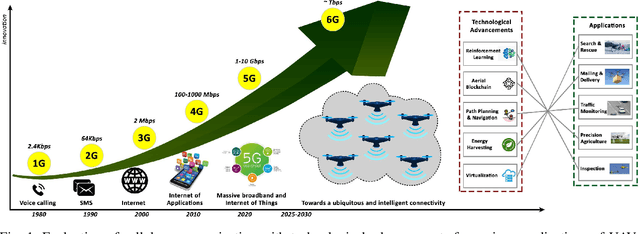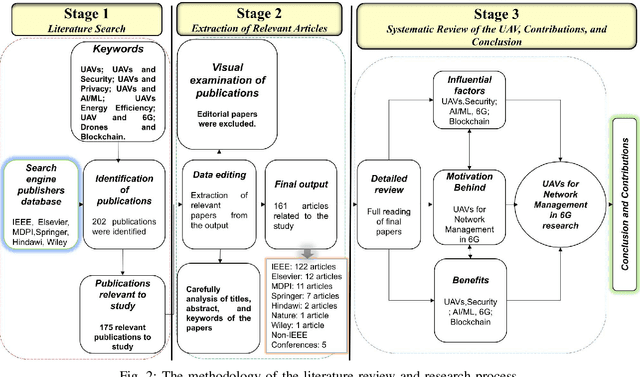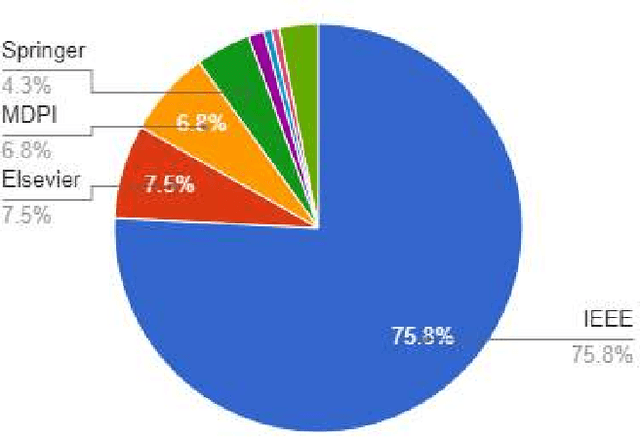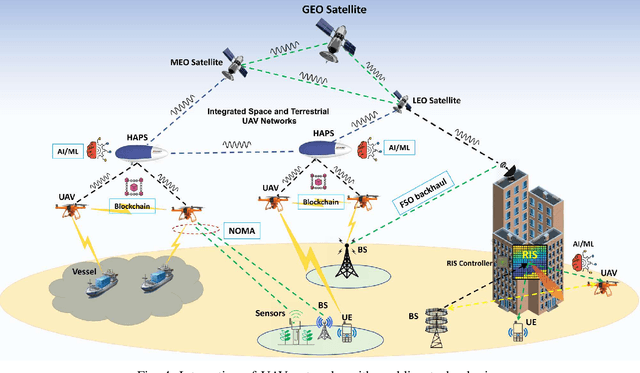Mohammed H. Alsharif
Swarm of UAVs for Network Management in 6G: A Technical Review
Oct 06, 2022



Abstract:Fifth-generation (5G) cellular networks have led to the implementation of beyond 5G (B5G) networks, which are capable of incorporating autonomous services to swarm of unmanned aerial vehicles (UAVs). They provide capacity expansion strategies to address massive connectivity issues and guarantee ultra-high throughput and low latency, especially in extreme or emergency situations where network density, bandwidth, and traffic patterns fluctuate. On the one hand, 6G technology integrates AI/ML, IoT, and blockchain to establish ultra-reliable, intelligent, secure, and ubiquitous UAV networks. 6G networks, on the other hand, rely on new enabling technologies such as air interface and transmission technologies, as well as a unique network design, posing new challenges for the swarm of UAVs. Keeping these challenges in mind, this article focuses on the security and privacy, intelligence, and energy-efficiency issues faced by swarms of UAVs operating in 6G mobile networks. In this state-of-the-art review, we integrated blockchain and AI/ML with UAV networks utilizing the 6G ecosystem. The key findings are then presented, and potential research challenges are identified. We conclude the review by shedding light on future research in this emerging field of research.
The Convergence of Blockchain, IoT and 6G: Potential, Opportunities, Challenges and Research Roadmap
Sep 07, 2021



Abstract:The world is undergoing a profound transformation with the advent of intelligent information era. 6G networks envisioned being the game changer in next generation wireless communication systems that will address the challenges of limited information speed escalated with the augmentation of billions of data applications encountered by the current fifth generation (5G) networks. Some key radical technologies in 6G together with existing 5G candidate schemes will guarantee the expected quality of experience (QoE) to attain ubiquitous wireless connectivity for the Internet of Everything (IoE) ranging from the telecom industry to digital smart industries. Blockchain technology (BCT) has gained significant attention due to undertake the decentralization, transparency, spectrum resource scarcity, inherent privacy and security, poor interoperability, confidentiality, and emerging smart applications domains including Industrial IoT and Industry 4.0. The mismatch between the requirements of many data intensive disruptive IoT applications and 5G network capabilities steered the demand of decentralized BCT based 6G architecture. Inspired by these facts, this paper studies an extensive survey to draw a new direction of blockchain integration into 6G mobile networks, IoT technologies, and smart industries focusing the potential merits and challenges in terms of infrastructure sharing, computational loads, latency, bandwidth overhead, business model, sustainability goals, and edge intelligence. We highlighted the convergence of IoT in blockchain to enable intelligent distribution in future industrial IoT and the technical model of 6G networks to realize the successful deployment of BCT schemes. This paper pointed out the current intriguing challenges, canvassed the mitigation techniques, and plausible future research opportunities that may benefit the pursuit of this vision.
 Add to Chrome
Add to Chrome Add to Firefox
Add to Firefox Add to Edge
Add to Edge